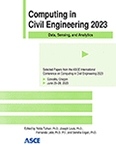Heuristic Optimization for Digital Twin Modeling of Existing Bridges from Point Cloud Data by Parametric Prototype Models
Publication: Computing in Civil Engineering 2023
ABSTRACT
Digital twins (DTs) can support the operation and maintenance process of bridges by providing a digital model representing the actual asset in reality. The underlying semantic-geometric model of bridges can be created from point cloud data (PCD), obtained by laser scanning or photogrammetry. The bridge PCD, however, needs to be processed and abstracted to a parametric model to handle geometric updates. Today, this process is conducted manually which in turn increases the geometric modeling costs. This paper aims to automate semantic segmentation and parametric modeling as essential steps in the geometric modeling of bridges. The point cloud of bridges is semantically segmented first through a deep-learning model. The value of parameters is then extracted by a heuristic optimization algorithm. Finally, the model of the entire bridge is created. The results of the paper show that the geometric modeling process of bridges can be automated to a large extent through computational methods.
Get full access to this article
View all available purchase options and get full access to this chapter.
REFERENCES
ASCE. (2021). ASCE’s 2021 Infrastructure Report Card.
Girardet, A., and C. Boton. (2021). “A parametric BIM approach to foster bridge project design and analysis.” Automation in Construction 126: 103679.
Hu, F., et al. (2021). “Structure‐aware 3D reconstruction for cable‐stayed bridges: A learning‐based method.” Computer‐Aided Civil and Infrastructure Engineering 36(1): 89–108.
Hu, Q., et al. (2020). Randla-net: Efficient semantic segmentation of large-scale point clouds. Proceedings of the IEEE/CVF Conference on Computer Vision and Pattern Recognition.
Lee, J. H., et al. (2020). “Automatic bridge design parameter extraction for scan-to-BIM.” Applied Sciences 10(20): 7346.
Lee, J. S., et al. (2021). “Semantic segmentation of bridge components based on hierarchical point cloud model.” Automation in Construction 130: 103847.
Lu, Q., et al. (2020). “Semi-automatic geometric digital twinning for existing buildings based on images and CAD drawings.” Automation in Construction 115: 103183.
Lu, R., et al. (2019). “Detection of structural components in point clouds of existing RC bridges.” Computer‐Aided Civil and Infrastructure Engineering 34(3): 191–212.
Mafipour, M. S., et al. (2021). Deriving Digital Twin Models of Existing Bridges from Point Cloud Data Using Parametric Models and Metaheuristic Algorithms. Proc. of the EG-ICE Conference 2021.
Pan, Y., et al. (2019). “Three-dimensional reconstruction of structural surface model of heritage bridges using UAV-based photogrammetric point clouds.” Remote Sensing 11(10): 1204.
Qi, C. R., et al. (2017). Pointnet: Deep learning on point sets for 3d classification and segmentation. Proceedings of the IEEE conference on computer vision and pattern recognition DOI: https://doi.org/10.1109/CVPR.2017.16.
Qin, G., et al. (2021). “Automated Reconstruction of Parametric BIM for Bridge Based on Terrestrial Laser Scanning Data.” Advances in Civil Engineering 2021 DOI: https://doi.org/10.1155/2021/8899323.
Rusu, R. B., et al. (2008). Aligning point cloud views using persistent feature histograms. 2008 IEEE/RSJ international conference on intelligent robots and systems, IEEE.
Truong-Hong, L., and R. Lindenbergh. (2022). “Automatically extracting surfaces of reinforced concrete bridges from terrestrial laser scanning point clouds.” Automation in Construction 135: 104127.
Vilgertshofer, S., et al. (2022). TwinGen: Advanced technologies to automatically generate digital twins for operation and maintenance of existing bridges. Proc. of European Conference on Product and Process Modeling 2022.
Wang, Y., et al. (2019). “Dynamic graph cnn for learning on point clouds.” Acm Transactions On Graphics (tog) 38(5): 1–12.
Xia, T., et al. (2022). “Automated semantic segmentation of bridge point cloud based on local descriptor and machine learning.” Automation in Construction 133: 103992.
Yan, Y., and J. F. Hajjar. (2021). “Automated extraction of structural elements in steel girder bridges from laser point clouds.” Automation in Construction 125: 103582.
Information & Authors
Information
Published In
History
Published online: Jan 25, 2024
ASCE Technical Topics:
- Algorithms
- Architectural engineering
- Bridge engineering
- Bridge management
- Bridges
- Building management
- Computer networks
- Computing in civil engineering
- Design (by type)
- Engineering fundamentals
- Geometrics
- Highway and road design
- Maintenance and operation
- Mathematics
- Models (by type)
- Optimization models
- Parameters (statistics)
- Statistics
- Structural engineering
Authors
Metrics & Citations
Metrics
Citations
Download citation
If you have the appropriate software installed, you can download article citation data to the citation manager of your choice. Simply select your manager software from the list below and click Download.
